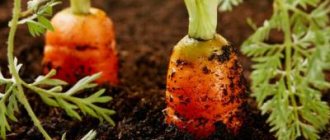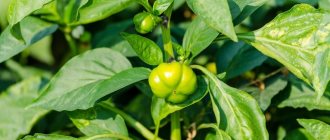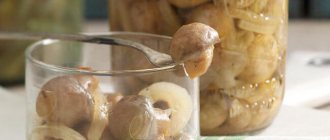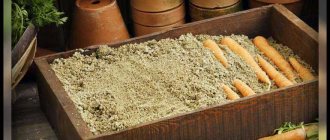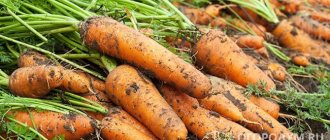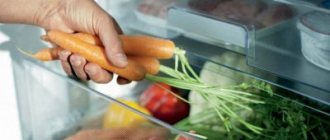Every gardener tries to grow the ideal crop, adhering to all the rules of planting and care. Growing carrots is a popular trend as this root vegetable is not only widely used in cooking but also has many health benefits. When choosing the next new variety of seeds, looking at the packaging, you can contemplate an even, smooth, impeccable shape and the same size, bright orange color, full of nutritious carrot juice. Manufacturers specializing in the procurement of seed products promise abundant harvests of root crops, high-quality ripening and the possibility of long-term storage. This is what every gardener would like to see when harvesting, but, unfortunately, expectation and reality do not always coincide.
Root crops grow gnarled, “horned,” long and thin, completely losing their characteristic vegetable appearance, juiciness and color. Quite often, you can dig up already wilted root crops directly from the ground. Let's figure out what can cause carrots to become limp while still in the ground.
It is difficult to name one single reason why it can be clearly concluded that this particular problem affects the texture of the root crop, and eliminating it will completely correct the quality of the carrots.
Rhizoctonia spores
Vegetable breeders claim that the culprit is diseases of vegetable crops and spores of fungal bacteria that travel by air from one plant to another, affecting increasingly large areas of vegetable beds. The once beautiful, bright green tops of carrots become yellow, and the root crop withers and, by the time of harvest, becomes completely unsuitable for consumption and long-term storage. There is a specific name for this disease; the root crop is affected by rhizoctonia - a dangerous fungal disease of vegetable crops that can destroy the entire carrot crop in a short period of time.
The disease is very insidious. The causative spores of this fungal infection overwinter well in the soil and on the root crops themselves in storage. Therefore, even if the harvested crop does not have obvious signs of lethargy, then during long-term storage they will certainly appear, and the tight carrot pulp will become soft, and the root vegetable itself will not be suitable for consumption. Carrots will lose all their beneficial qualities, juiciness and even color.
How does rhizoctonia appear on the site? The “existence” of rhizoctonia in garden beds is caused by non-compliance with crop rotation, sowing carrot seeds after harvesting beets, parsley or turnips. Conclusion, for carrot root crops to grow successfully, you need to choose a new bed every year.
Preventive measures
In order for carrots to be stored for a long time, it is necessary to provide them with the proper conditions, namely:
- observe crop rotation;
- weeding;
- thin out young plants;
- plant crops on loose and light soils;
- harvest in dry and warm weather;
- treat storage facilities with sulfur bombs;
- destroy affected root crops;
- store indoors at temperatures from 0°C to –2°C and relative humidity 85–90%;
- choose rot-resistant varieties.
Important! Constant air circulation must be ensured in storage areas for carrots.
If you take proper care of your carrots and follow the above recommendations, you can get a good harvest in the fall, which will delight you with long-term preservation.
Incorrect watering during planting and caring for carrots
Waterlogging of the soil in the beds also leads to lesions and lethargy of carrot fruits. Excess moisture causes cracks to appear on carrots, in which disease spores settle. Groundwater that keeps the soil moist is also harmful to root crops. And if you add frequent watering to them, you may not get a harvest at all.
How to properly water carrots to avoid limp roots in the ground? Amateur gardeners, sharing personal experience, claim that carrot beds should be thoroughly moistened during seed germination and root formation. Throughout the growth of carrots, it is recommended to water in moderation. Before harvesting root crops, two to three weeks before, watering is completely avoided. And in a couple of days, the amount of moisture is maximized. With this mode of moistening the carrot bed, “garden craftsmen” guarantee the absence of limp fruits. They say that carrots turn out very juicy and tasty.
Selection of containers
The necessary conditions are more or less clear; now it’s worth deciding where to store it so that the root crop remains in good condition longer.
There are also several popular methods here:
Boxes
The simplest and most popular method. Just put the root crop in a box in layers, you can sprinkle it with sand, and then send it to the basement or onto the balcony. It is best to choose large boxes designed for 20-30 kilograms of carrots.
In clay
Many gardeners recommend treating vegetables with clay or lime mortar. To achieve the desired effect, the solution should be similar in consistency to sour cream. Dip the root crop into the resulting mass, then let the excess drain. Now we put the carrots either just in a pile or in boxes. After a few days, when the solution has completely dried, the carrots will receive reliable protection from disease and wilting.
Packages
Storing vegetables in a bag can be considered one of the most effective options. In this case, crop losses can be almost completely avoided. Just put the carrots in bags and leave them open so that they maintain the required level of moisture, which will have a beneficial effect on the fruits.
On a note. You should not tie the bags, otherwise moisture will accumulate at the bottom and the carrots will begin to rot and deteriorate.
Banks
The method of storage in jars is very similar to the previous one. But it is very important here that the jars are clean and dry. Some even recommend boiling the jars first. The carrots are not stacked tightly so as not to interfere with air circulation. It is advisable to store it in a dark place without covering it with a lid. Read more about storing carrots in jars and boxes here.
Lack of systematic loosening of beds and thinning of crops
Careful and proper care of carrots involves periodic thinning of crops and mandatory loosening of the top layer of soil. If the plantings are dense, then the fruits simply do not have enough room to grow, they stretch out and take on ugly shapes.
The top layer of soil, hard and cracked after watering, prevents the penetration of oxygen, nutrition and moisture to the roots of the plant. Thus, a root crop grown in a garden bed without proper loosening will certainly wither before reaching technical maturity.
Infected seeds
Many gardeners, especially beginners, completely rely on the manufacturer, who indicates on the package label that the seed is processed and completely ready for sowing and, often, does not disinfect the seed.
It is still worth carrying out disinfection measures with seeds. How to disinfect carrots before planting? Immersing the contents of the package for some time in a weak solution of potassium manganese will disinfect the seeds. In this simple way, you can prevent the accumulation and development of spores of pathogenic bacteria, and will prevent the development of diseases and lethargy of the root crop while still in the ground.
How carrots like to be stored: carrot secrets
- The optimal temperature for storing carrots is 0…+3 °C. At +5 °C the dormant period of the root crop ends: it begins to germinate!
- A humidity is about 85-90%. Carrots do not like too dry air: they quickly wither and become wooden.
- Carrots do not like intensive ventilation. And not because of air humidity: the level of carbon dioxide, a natural preservative that slows down germination at elevated temperatures and preserves the marketable appearance of the root crop, is important.
- It is believed that the CO2 level in the room for carrots is 3-5%. Few people will measure it, but remember this is important: carrots do not like drafts.
And we also beware of “bad” neighbors that emit ethylene
, a gas that promotes rapid ripening of fruits.
These are apples, pumpkins, pears.
It is advisable to store them separately, or in containers (bags, for example), if side by side.
Excessive fertilization
The benefits of additional nutrition in the form of complex additives, minerals, acids, amino acids and rotted organic matter are undeniable. But, both moisture and fertilizers must be applied only in the recommended quantities and doses, because anything that is too much is not healthy.
For example, an excess of nitrogen-containing compounds in the soil allows root vegetables to accumulate nitrates in their pulp, which significantly affects the yield and appearance of the vegetable. With an excess of nutrition and moisture, the fruits crack and wither while still in the ground, before the period of full ripening. Conclusion, do not overdo it with fertilizing; strictly adhere to the carrot fertilizer calendar.
Long-term recycling methods at home
It often happens that harvested root vegetables are unsuitable for long-term fresh storage, for example, due to damage or size. In this case, it is worth processing carrots so as not to lose the harvest.
There are many recipes that will allow vegetables to be stored for a long time.
The most common are the following:
This storage method is very popular, especially if there are small children in the house. You can make quite a lot of dishes based on carrot puree or simply use it as food. You can add apple, pear, and pumpkin puree to it and get a completely new taste.
The simplest recipe includes a minimum of ingredients.
- Boil a kilogram of carrots with a minimum amount of liquid, pass through a sieve or grind in a blender.
- Add sugar to taste, about 100 grams and a little salt.
- Mix and pour into jars. Ready.
Salting
Pickling is another popular way to preserve crops in winter.
- A kilogram of carrots must be grated on a coarse grater; finely chopped dill can be added if desired.
- Next, add 4 tablespoons of salt and mix very well.
- Now transfer the resulting mixture into sterilized jars and close with plastic lids.
Pickles can be stored all winter, but only in the refrigerator. This dish will be an excellent healthy side dish that will remind you of summer.
Korean salad
In another way it is called carrot “in Korean”. Today this dish is very popular because it can not only be simply eaten, but also used as an addition to various dishes. Korean salad can be easily and quickly prepared at home.
First you need to grate a kilogram of vegetables; there are special graters that allow you to chop carrots into long strips, but you can get by with regular ones. It all depends on your desire.- Crush the head of garlic and add to the carrots. It depends on how spicy the resulting salad will be.
- Now you need to season everything well, you need black and red pepper, cloves, coriander, bay leaf, now add salt and a tablespoon of sugar, mix well.
- Season the salad with vegetable oil, about half a glass, add 4 tablespoons of vinegar.
- To make the carrots more juicy, you can additionally crush them a little with your hands.
- Now we transfer the carrots into an enamel bowl and put them under the press. An ordinary three-liter jar of water is suitable for this. It will take about three days for the salad to brew. It is better to store carrots in the refrigerator or on the balcony.
As mentioned earlier, juice is very healthy, especially for children. Therefore, if you have a juicer, you can easily save it for the winter. Add sugar to taste and pour into sterile jars. It is better to cover it with a metal lid if you expect long-term storage.
To minimize losses when peeling carrots, it is best to use a vegetable peeler; it will allow you to quickly and accurately remove the peel from the root crop.
Can it be simply stored boiled?
Some housewives prefer to immediately prepare food before storing, which raises the question of whether it is possible to store carrots already cooked. You can, but don’t forget about the expiration date.
Do not worry that the product will lose vitamins; if stored properly, it will remain as useful as before heat treatment. Drying carrots may also be a good storage method.
Below you can see photos of different ways to store carrots in winter.
Carrot flies, aphids and leafhoppers are the causative agents of wilting of root crops
The consequence of the presence of weeds, thickened crops and waterlogged soil in vegetable beds is the settlement of insect pests.
The carrot fly lays down larvae, which later turn into worms and penetrate the pulp of the fruit. Affected carrots first simply wither and then rot, so when harvesting you can find not only limp, but also rotten root crops.
Aphids and leafhoppers drink juice from mechanically damaged carrot tops and transfer spores of fungal bacteria from the diseased plant to the healthy one. Crops affected in this way change their appearance, the tops of carrots turn yellow, and the fruit becomes covered with hairs and withers right in the ground. Conclusion, avoid the abundance of weeds that provoke the appearance of pests, and also do not forget to spray, for example, with bioinsecticides, which are harmless to humans, but destructive to pests. Read more about biological products that will help you easily cope with pests without harming humans in this article.
Diseases and pests that lead to rotting
Diseases and pests that cause damage to root crops include rot, carrot fly, aphids, mole crickets, nematodes, etc.
Diseases
Diseases caused by various fungi pose a great danger to maintaining the integrity of the vegetable.
Bacterial soft rot
This disease begins to appear in the garden and consists of the following symptoms::
- the leaves wither and darken, mucus appears on the tops;
- root vegetables become soft from the inside, emitting an unpleasant putrid odor, although they may still be intact on top;
- dark spots appear, quickly increasing in size;
- easily transferred to healthy root crops.
White rot
Most common among other diseases.
Premature absence of tops in root crops
Novice gardeners are also experimenters. Quite often you hear that in order to obtain larger and juicier fruits, the green tops of carrots should be cut off in September.
Undoubtedly, this opinion is wrong. Without the presence of the ground part in the form of green tops before the end of the growing season, the plant will stop its development and growth, and the formed root crop will simply wither. Conclusion, the above-ground part of carrots should remain until harvest.
If you prevent all possible causes of carrot wilting, you will not face such a misfortune as a sluggish harvest.
Storage errors
Listing the mistakes when preparing carrots for storage, it is necessary to say about its methods. Each housewife has her own - proven over the years, the best and most reliable. Someone keeps carrots in a warm cellar in boxes with sand, maintaining the room temperature at +10. +15°С. Someone puts root vegetables in boxes with wet sand and stores them at a temperature of +2. +5°C.
Each housewife has her own storage method.
Many summer residents prefer to process fruits with clay or chalk mash. Also, carrots collected at the dacha and brought to a city apartment for storage are transferred to plastic bags and placed in the refrigerator. Some city housewives chop fresh carrots on a grater and store them in freezers. You can read about varieties with good shelf life, as well as more information about methods of storing carrots, in the publication on our website How to store carrots correctly.
Some housewives grate carrots and freeze them
Any methods are good if they suit you, and there is no point in challenging them. However, classic mistakes still need to be listed.
- Last year's sand cannot be used for storage; it is better to replace it with new one. If this is not possible, then it is advisable to dry the bulk material on a hot summer day in the scorching sun or in the oven. In the fried sand, the fruits will be stored well and safely all winter.
- You should not store carrots if the clay or chalk solution on it has not completely dried, and some of it has crumbled during transportation. Such fruits require repeated processing.
- When stored in the refrigerator on the bottom shelf, it is necessary to regularly inspect and sort through the fruits and remove those that have begun to deteriorate. Optimum temperature +2. +4°C.
May your harvest be well stored
By adhering to the basic storage rules, as well as taking into account other people’s mistakes and failures, you can perfectly preserve your carrot harvest. Dear readers, how do you store your root vegetables? Share with us in the comments which methods are the best from your point of view.
Of all the root crops grown by gardeners in their summer cottages, carrots are the most difficult to preserve during the winter. The inquisitive minds of gardeners have come up with many ways to store carrots: in cellars, on balconies, in apartments and even directly in beds.
